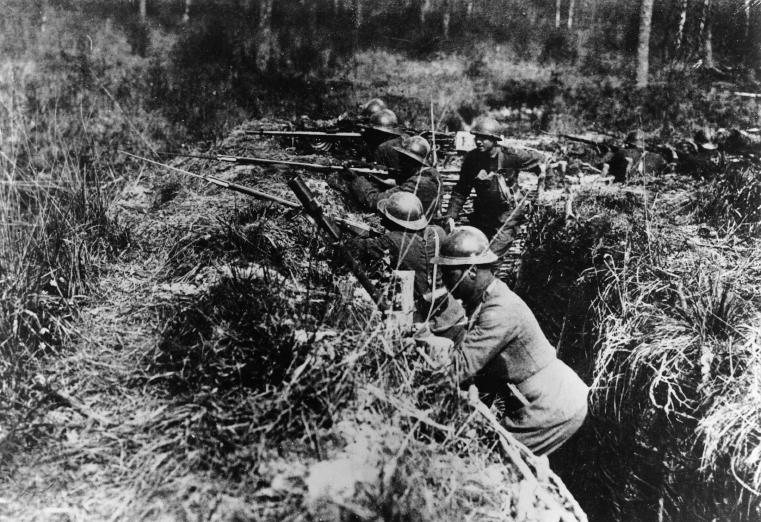Exploring American Histories: Printed Page 635
Exploring American Histories, Value Edition: Printed Page 527
Making the World Safe for Democracy
As 1917 dawned, the Great War headed toward its third bloody year. Neither side wanted a negotiated peace because each counted on victory to gain sufficient territory and financial compensation to justify the great sacrifices in human lives and materiel caused by the conflict. Nevertheless, Wilson tried to persuade the belligerents to abandon the battlefield for the bargaining table. On January 22, 1917, he declared that the world needed a “peace without victory,” one based on self-determination, freedom of the seas, respect for international law, and the end of hostile alliances. It was a generous vision from a nation that had made few sacrifices.
Germany quickly rejected Wilson’s proposal. America had never been truly neutral, and Germany’s increasingly desperate leaders saw no reason to believe that the situation would change. In 1915 and again in 1916, to prevent the United States from entering the war, Germany had pledged to refrain from using its most potent weapon, the U-boat, against passenger ships and merchant ships. However, the Germans now chose to change course and resume unrestricted submarine warfare, calculating that they could defeat the Allies before the United States declared war and its troops could make a substantial difference. On February 1, 1917, Germany announced that it would attack all ships, including unarmed American merchant vessels that penetrated its blockade of Great Britain. In response, Wilson used his executive power to arm merchant ships, bringing the United States one step closer to war.
The country moved even closer to war after the Zimmermann telegram became public. On February 24, the British turned over to Wilson an intercepted message from Arthur Zimmermann, the German foreign minister, to the Mexican government. The decoded note revealed that Germany had offered Mexico an alliance in the event that the United States joined the Allies. If the Central Powers won, Mexico would receive the territory it had lost to the United States in the mid-nineteenth century—Texas, New Mexico, and Arizona. When U.S. newspapers broke the story several days later, it inflamed public opinion and provided the Wilson administration another reason to fear a German victory.
In late February and March, German U-boats sank several armed American merchant ships, and on April 2, 1917, President Wilson asked Congress to declare war against Germany and the other Central Powers. After four days of vigorous debate led by opponents of the war—including the first female elected representative, Jeanette P. Rankin from Montana—Congress voted to approve the war resolution. However, the United States underscored its historic commitment against “entangling alliances” by refusing to officially join the Allies, instead declaring itself an “Associated Power.”
Explore
See Document 20.3 for one senator’s argument against going to war.
President Wilson had not reached his decision lightly. For three years, he resisted calls for war. His policies had tended to favor the Allies, but the president understood that going to war would have grave consequences. He knew that he would be sending thousands of American men to their deaths and that the “spirit of ruthless brutality [would] enter the very fiber of our national life.” In the end, however, Wilson decided that only by going to war would he be able to ensure that the United States played a role in shaping the peace. For the president, the security of the nation rested on respect for law, human rights, and extension of free governments. “The world must be made safe for democracy,” he informed Congress in his war message, and he had concluded that the only way to guarantee this outcome was by helping to defeat Germany.
It would take a while for Americans to live up to the lyrics of George M. Cohan’s patriotic song “Over There,” which announced that “the Yanks [were] coming” to rescue the Allies from defeat. First, the United States needed a large army, which it created through the draft. The Selective Service Act of 1917 conscripted 3 million men by war’s end. Mobilizing such a large force required substantial time, and American troops on the battlefield did not make much of an impact until 1918. Before then, the U.S. navy made the greatest contribution. American warships joined the British in escorting merchant vessels, combating German submarines, and laying mines in the North Sea. The United States also provided crucial funding and supplies to the Allies as their reserves became depleted.
U.S. troops finally began to make an impact in Europe in May 1918. Allied forces were exhausted and weary, and in November 1917 they had suffered a further blow when the Russian Revolution installed a Bolshevik (Communist) regime that negotiated a separate peace with the Central Powers. Fresh recruits from the United States helped shift the war toward Allied victory. From May through September, more than 1 million American troops under the command of General Pershing helped the Allies repel German offensives in northern France near the Belgian border. One momentous battle in the Argonne Forest lasted two months until the Allies broke through enemy lines and pushed toward Germany. Nearly 50,000 American troops died in the fierce fighting, and another 230,000 were injured. Like their European counterparts, who suffered a staggering 8 to 10 million casualties, Americans experienced the horrors of war magnified by new technology. Dug into filthy trenches, soldiers dodged rapid machine-gun fire, heavy artillery explosions, and poison gas shells. In the end, however, American troops succeeded in tipping the balance in favor of the Allies. On November 11, 1918, an exhausted Germany surrendered.

Review & Relate
|
In what ways, if any, did President Wilson’s approach to Latin American affairs differ from that of his predecessors? |
Why did President Wilson find it so difficult to keep the United States out of World War I? |